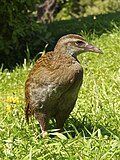Gallirallus
| Gallirallus | |
|---|---|

| |
| Weka, Gallirallus australis | |
| Scientific classification | |
| Kingdom: | Animalia |
| Phylum: | Chordata |
| Class: | Aves |
| Order: | Gruiformes |
| Family: | Rallidae |
| Genus: | Gallirallus Lafresnaye, 1841 |
| Species | |
|
2 living, and see text | |
| Synonyms | |
| |
Gallirallus is a genus of rails that live in the Australasian-Pacific region. The genus is characterised by an ability to colonise relatively small and isolated islands and thereafter to evolve flightless forms, many of which became extinct following Polynesian settlement.
Description[]
Many of the rails, including the well-known weka of New Zealand, are flightless or nearly so. Many of the resultant flightless island endemics became extinct after the arrival of humans, which hunted these birds for food, introduced novel predators like rats, dogs or pigs, and upset the local ecosystems. A common Polynesian name of these rails, mainly relatives of G. philippensis, is veka/weka (in English, this name is generally limited to Gallirallus australis).
On the other hand, Gallirallus species are (with the exception of the weka) notoriously retiring and shy birds with often drab coloration.
Living and recently extinct species[]
In the online list maintained by Frank Gill, Pamela Rasmussen and David Donsker on behalf of the International Ornithological Committee (IOC), the genus contains two species:[1]
| Image | Scientific name | Common Name | Distribution |
|---|---|---|---|
 |
Weka | Gallirallus australis | New Zealand |
| Calayan rail | Gallirallus calayanensis | Calayan Island in the Philippines. |
These species are placed by BirdLife International and IUCN in the separate genus Hypotaenidia but are still considered part of Gallirallus by The Clements Checklist of Birds of the World/eBird:
- Okinawa rail, Gallirallus okinawae
- Barred rail, Gallirallus torquatus
- Pink-legged rail, Gallirallus insignis
- Roviana rail, Gallirallus rovianae
- Guam rail, Gallirallus owstoni - extinct in the wild (late 1980s)
- Lord Howe woodhen, Gallirallus sylvestris
- Buff-banded rail, Gallirallus philippensis
- Dieffenbach's rail, Gallirallus dieffenbachii - extinct (mid-19th century)
- Wake Island rail, Gallirallus wakensis - extinct (1945)
- Tahiti rail, Gallirallus pacificus - extinct (late 18th - 19th century)
Species extinct before A.D. 1500[]

- , Gallirallus astolfoi[2]
- Nuku Hiva rail, Gallirallus epulare[3]
- , Gallirallus ernstmayri
- Ua Huka rail, Gallirallus gracilitibia[3]
- Niue rail, Gallirallus huiatua [4][5]
- , Gallirallus pendiculentus
- , Gallirallus pisonii
- Mangaia rail, Gallirallus ripleyi[6]
- Tahuata rail, Gallirallus roletti[3]
- Tubuai rail, Gallirallus steadmani[7]
- Huahine rail, Gallirallus storrsolsoni
- , Gallirallus temptatus
- ‘Eua rail, Gallirallus vekamatolu - possibly survived to the early 19th century[8][9]
- Hiva Oa rail, ?Gallirallus sp.
- , Gallirallus [Hypotaenidia] vavauensis Worthy & Burley 2020.[10]
References[]
- ^ Gill, Frank; Donsker, David; Rasmussen, Pamela, eds. (2020). "Flufftails, finfoots, rails, trumpeters, cranes, limpkin". IOC World Bird List Version 10.2. International Ornithologists' Union. Retrieved 7 August 2020.
- ^ Salvador, Rodrigo B.; Anderson, Atholl; Tennyson, Alan J.D. (2021). "An Extinct New Rail (Gallirallus, Aves: Rallidae) Species from Rapa Island, French Polynesia". Taxonomy. 1 (4): 448–457. doi:10.3390/taxonomy1040032.
- ^ a b c Kirchman, Jeremy J.; Steadman, David. (2007). "New species of extinct rails (Aves: Rallidae) from archaeological sites in the Marquesas Islands, French Polynesia". Pacific Science. 61 (1): 145–163. doi:10.1353/psc.2007.0008. hdl:10125/22605. S2CID 86793953. Archived from the original on 2014-06-11.(subscription required)
- ^ "Gallirallus huiatua; holotype". Collections Online. Museum of New Zealand Te Papa Tongarewa. Retrieved 16 July 2010.
- ^ Steadman, David W.; Worthy, Trevor H.; Anderson, Atholl J.; Walter, Richard. (2000-06-01). "New species and records of birds from prehistoric sites on Niue, southwest Pacific". Wilson Bulletin. 112 (2): 165–186. doi:10.1676/0043-5643(2000)112[0165:NSAROB]2.0.CO;2. Archived from the original on 2007-05-24.(subscription required)
- ^ Steadman, D. W. (1986). "Two new species of rails (Aves: Rallidae) from Mangaia, Southern Cook Islands". Pacific Science. 40 (1): 27–43.
- ^ Worthy, Trevor H.; Bollt, Robert. (2011-01-01). "Prehistoric birds and bats from the Atiahara site, Tubuai, Austral Islands, East Polynesia". Pacific Science. 65 (1): 69–86. doi:10.2984/65.1.069. hdl:10125/23211. S2CID 54836563. Archived from the original on 2014-09-21.(subscription required)
- ^ A similar bird was found to live on nearby Vava‘u in 1793. Given that G. vekamatolu was flightless, this may just as well represent a related species.
- ^ Kirchman, J.J.; Steadman, D. W. (2005). "Rails (Aves: Rallidae: Gallirallus) from prehistoric sites in the Kingdom of Tonga, including description of a new species". Proceedings of the Biological Society of Washington. 118 (2): 465–477. doi:10.2988/0006-324x(2005)118[465:rargfp]2.0.co;2.
- ^ Worthy, Trevor H.; Burley, David V. (2020). "Prehistoric avifaunas from the Kingdom of Tonga". Zoological Journal of the Linnean Society. 189 (3): 998–1045. doi:10.1093/zoolinnean/zlz110.
External links[]
 Media related to Gallirallus at Wikimedia Commons
Media related to Gallirallus at Wikimedia Commons Data related to Gallirallus at Wikispecies
Data related to Gallirallus at Wikispecies
- Gallirallus
- Bird genera